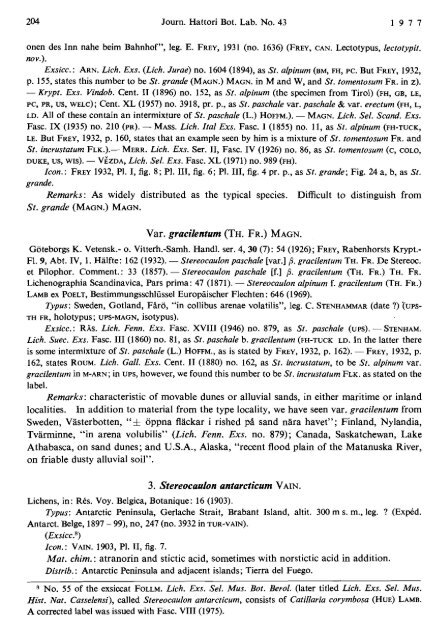A CONSPECTUS OF THE LICHEN GENUS STEREOCAULON ...
A CONSPECTUS OF THE LICHEN GENUS STEREOCAULON ...
A CONSPECTUS OF THE LICHEN GENUS STEREOCAULON ...
You also want an ePaper? Increase the reach of your titles
YUMPU automatically turns print PDFs into web optimized ePapers that Google loves.
204 Journ. Hattori Bot. Lab. No. 43 1977<br />
onen des Inn nahe beim Bahnhof", leg. E. FREY, 1931 (no. 1636) (FREY, CAN. Lectotypus, lectotypit.<br />
mv.).<br />
Exsicc.: ARN. Lich. EXS. (Lich. Jurae) no. 1604 (1894), as St. alpinum (BM, FH, PC. But FREY, 1932,<br />
p. 155, states this number to be St. grande (MAGN.) MAGN. in M and W, and St. tomentosum FR. in z).<br />
- Krypt. Exs. Vidob. Cent. I1 (1896) no. 152, as St. alpinum (the specimen from Tirol) (FH, GB, LE,<br />
PC, PR, US, WELC); Cent. XL (1957) no. 3918, pr. p., as St. paschale var. paschale & var. erectum (FH, L,<br />
Lich. Sel. Scad. Exs.<br />
LD. All of these contain an intermixture of St. paschale (L.) H<strong>OF</strong>FM.). - MAGN.<br />
Fasc. IX (1935) no. 210 (PR). - MASS. Lich. Ztal EXS. Fasc. I (1855) no. 11, as St. alpinum (FH-TUCK,<br />
LE. But FREY, 1932, p. 160, states that an example seen by him is a mixture of St. tomentosum FR. and<br />
St. incrustatum FLK.).- MERR. Lich. Exs. Ser. 11, Fasc. IV (1926) no. 86, as St. tomentosum (c, co~o,<br />
DUKE, US, WIS). - VEZDA, Lich. Sel. Exs. Fasc. XL (1971) no. 989 (FH).<br />
Zcon.: FREY 1932, PI. I, fig. 8; PI. 111, fig. 6; PI. 111, fig. 4 pr. p., as St. grade; Fig. 24 a, b, as St.<br />
grande.<br />
Remarks: As widely distributed as the typical species. Difficult to distinguish from<br />
St. grande (MAGN.) MAGN.<br />
Var. gracilentum (TH. FR.) MAGN.<br />
Goteborgs K. Vetensk.- o. Vitterh.-Samh. Handl. ser. 4, 30 (7): 54 (1926); FREY, Rabenhorsts Krypt.-<br />
F1.9, Abt. IV, 1. Halfte: 162 (1932). - Stereocaulon paschale [var.] P. gracilentum TH. FR. De Stereoc.<br />
et Pilophor. Comment.: 33 (1857). - Stereocaulon paschale [f.] P. gracilentum (TH. FR.) TH. FR.<br />
Lichenographia Scandinavica, Pars prima: 47 (1871). - Stereocaulon alpinum f. gracilentum (TH. FR.)<br />
LAMB ex POELT, Bestimmungsschliisse1 Europaischer Flechten: 646 (1969).<br />
Typus: Sweden, Gotland, Fare, "in collibus arenae volatilis", leg. C. STENHAMMAR (date ?) '(ups-<br />
TH FR, holotypus; UPS-MAGN, isotypus).<br />
Exsicc.: RAs. Lich. Fenn. Exs. Fasc. XVIII (1946) no. 879, as St. paschale (UPS). STENHAM.<br />
Lich. Suec. Exs. Fasc. 111 (1860) no. 81, as St. paschale b. gracilentum (FH-TUCK LD. In the latter there<br />
is some intermixture of St. paschale (L.) H<strong>OF</strong>FM., as is stated by FREY, 1932, p. 162). - FREY, 1932, p.<br />
162, states ROUM. Lich. Gall. Exs. Cent. I1 (1880) no. 162, as St. incrustatum, to be St. alpinum var.<br />
gracilentum in M-ARN; in UPS, however, we found this number to be St. incrustatum FLK. as stated on the<br />
label.<br />
Remarks: characteristic of movable dunes or alluvial sands, in either maritime or inland<br />
localities. In addition to material from the type locality, we have seen var. gracilentum from<br />
Sweden, Vasterbotten, "f oppna flackar i rished pi sand nara havet"; Finland, Nylandia,<br />
Tvarminne, "in arena volubilis" (Lich. Fenn. Exs. no. 879); Canada, Saskatchewan, Lake<br />
Athabasca, on sand dunes; and U.S.A., Alaska, "recent flood plain of the Matanuska River,<br />
on friable dusty alluvial soil".<br />
3. Stereocaulon antarcticum VAIN.<br />
Lichens, in: Rks. Voy. Belgica, Botanique: 16 (1903).<br />
Typus: Antarctic Peninsula, Gerlache Strait, Brabant Island, altit. 300 m s. m., leg. ? (Exp6d.<br />
Antarct. Belge, 1897 - 99), no, 247 (no. 3932 in TUR-VAIN).<br />
(EXS~CC.~)<br />
Zcon. : VAIN. 1903, PI. 11, fig. 7.<br />
Mat. chim. : atranorin and stictic acid, sometimes with norstictic acid in addition.<br />
Distrib.: Antarctic Peninsula and adjacent islands; Tierra del Fuego.<br />
No. 55 of the exsiccat FOLLM.<br />
Lich. Exs. Sel. Mus. Bot. Berol. (later titled Lich. Exs. Sel. Mus.<br />
Hist. Nat. Casselensi), called Stereocaulon antarcticum, consists of Catillaria corymbosa (HUE) LAMB.<br />
A corrected label was issued with Fasc. VIII (1975).

















